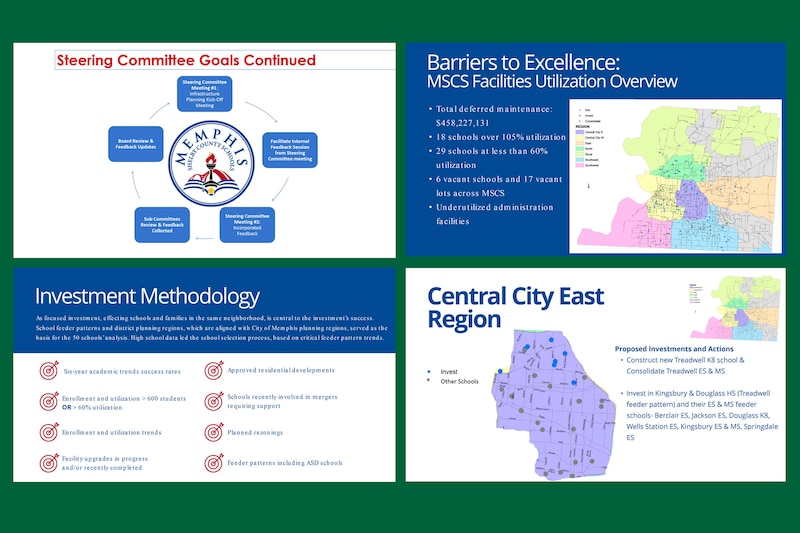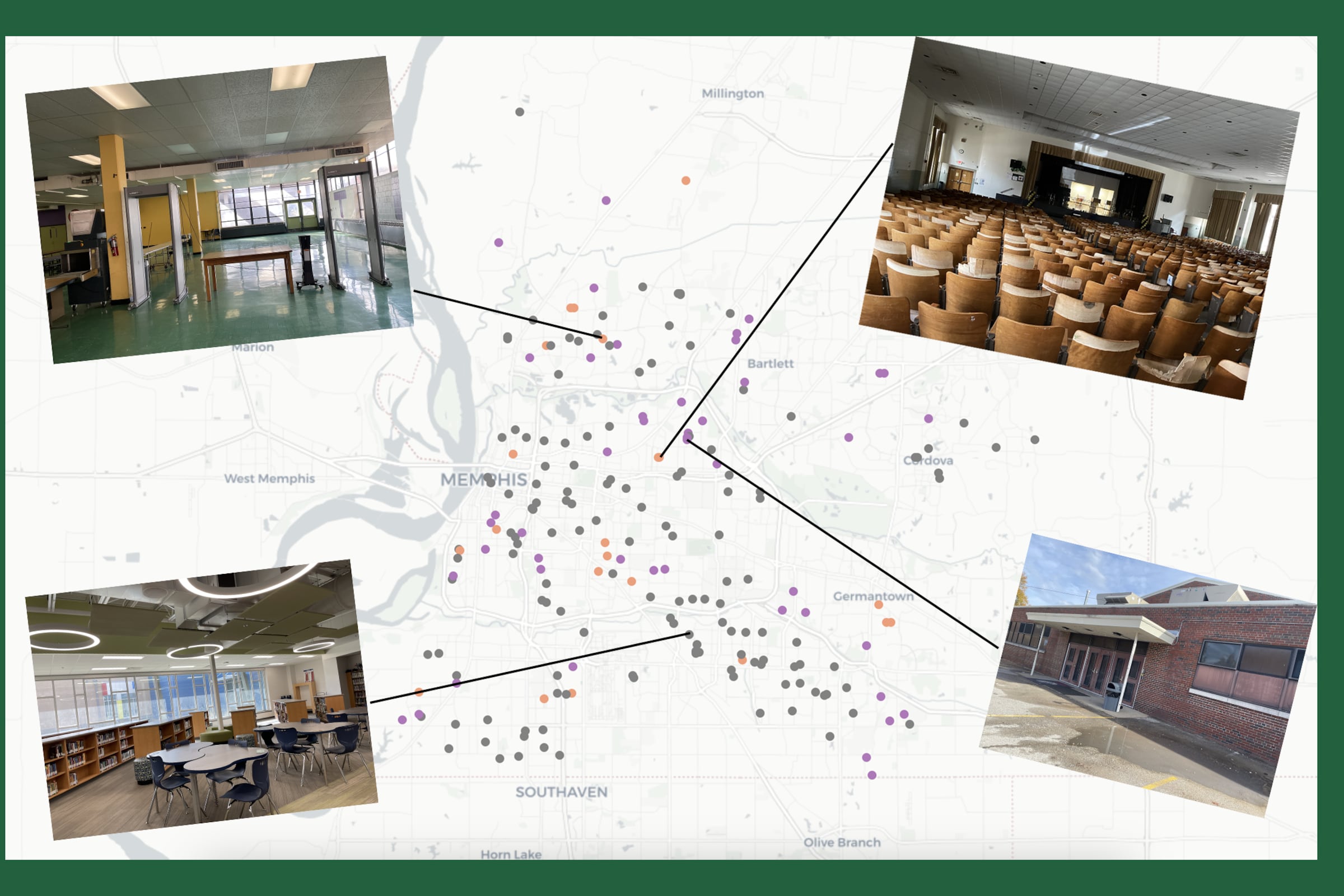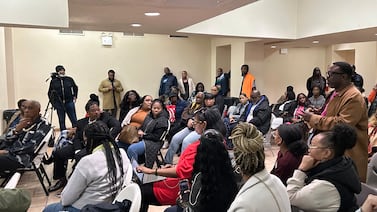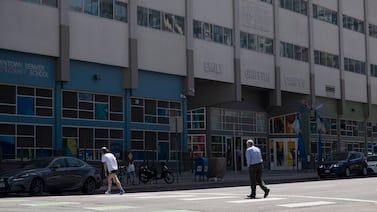Sign up for Chalkbeat Tennessee’s free daily newsletter to keep up with Memphis-Shelby County Schools and statewide education policy.
Nearly 50 Memphis-Shelby County public schools would receive new investments for their physical buildings or their academic programming under an ambitious plan that district leaders are developing in an effort to improve learning experiences for children.
Another 21 school buildings could close under the plan, district documents show, meaning their students would have to go to school elsewhere.
In all, nearly half of the district’s buildings, and their communities, could be affected if the district follows through on the plan.
The facility plan is described in general terms in draft documents and maps compiled by Memphis-Shelby County Schools that Chalkbeat obtained through open-records requests. Chalkbeat used further research to identify the specific schools targeted for new investments or closure. (To learn more about how Chalkbeat reported this, see below.)
The broad plan has been shown to select community members convening for early rounds of input, along with maps showing the school locations, but the documents haven’t been shared in any public forum. Chalkbeat’s analysis of the documents provides the general public with the first look at which schools the district is considering for possible closure or consolidation, all identified by name.
The plan is still in the draft stage as district leaders collect feedback from some community partners. But as described in the documents, it represents an effort by district leaders to formulate a comprehensive strategy to tackle a complex set of problems: academic struggles that undermine faith in public schools, persistent funding shortages for capital projects, enrollment shifts, and the high cost of maintenance for aging buildings.
“I think it’s appropriate to have an investment discussion before you have a closure discussion,” interim Superintendent Toni Williams recently told a group gathered at Colonial Middle School to discuss the draft plan.
In touting their approach over the past year, school district leaders have said they want their infrastructure vision to stand out from previous ones in key ways: They want the community to feel involved in the decisions. They want to play a more active role in facilitating redevelopments when schools close, so that neighborhoods aren’t left with empty buildings.
And they want the plan to stick.
Community partners are helping to shape the facilities plan
In presentations in the fall and winter, officials have suggested that a first round of building changes would take place over the next five years, with more to come. Board policy describes a set of community meetings and reports that must take place by the end of February for any school to be closed by the following fall.
The district has been active in engaging community partners, and has convened one steering committee and nine neighborhood-based subcommittees to solicit input on the general draft plans. Many of the roughly 100 people across those committees — comprising school board members, other elected and government officials, plus business leaders, community leaders, parents, and students — have already received the district’s early proposals, which include the maps that show where major changes would take place.
The maps produced by the district use color-coded dots to show the locations of schools targeted for investment or possible closure, but the district documents don’t identify the schools by name. Using other public records, Chalkbeat was able to connect the dots with the school names to give Memphians a clearer picture of the proposals the school district is making.
Chalkbeat’s review did not include preschool locations or administrative buildings, which are also set for changes.
Chalkbeat gave the district an opportunity to review the matched data that it compiled based on the district’s documents, to check its accuracy, correct any discrepancies, and provide updates. District officials did not dispute the specific information we shared.
The district responded with a copy of a statement from Williams that was published to social media on Jan. 24 and distributed to district employees. The statement broadly dismissed any reporting about plans for Memphis school buildings.
“Any potential changes to our educational landscape will only be brought forth after thorough evaluation, community engagement, and formal board approval,” the statement said.
Several MSCS board members contacted by Chalkbeat said that figuring out how to deal with the district’s building issues is a critical step, but stressed that the plan is still being worked out with the community.
“We need probably fewer schools so we can offer more things to the schools that we have,” board member Mauricio Calvo said. He said he recalled a school visit where students without desks were seated on filing cabinets, and their librarian was wearing multiple scarves to stay warm.
He said that difficult conversations about how the district uses its resources can lead to better learning experiences but that any board decisions about closures are still months away.
Board member Michelle McKissack said, “It’s going to take an entire community” to figure out how to deal with the legacy of decades of deferred maintenance and declining conditions in school buildings. “So that’s where we are right now.”
In an email to Chalkbeat, board member Amber Huett-Garcia said she was concerned that publishing the names of schools that may close could be “destabilizing” to communities amid district efforts to “build a culture of trust, safety, and achievement.”
“Nothing is decided right now,” she wrote, “and words such as draft or pending community input can be lost.”
Board Chair Althea Greene, pointing to the community meetings that are underway, said in a statement: “Our goal is to continue to be transparent throughout this process.”
How the Memphis district is analyzing schools
To sort out which schools would be affected and how, the draft proposal looks at a combination of criteria describing a school’s academic performance, enrollment, capacity, and facility needs. The district has said it analyzed those factors alongside how the school fits into district feeder patterns — the set of schools that students in a particular community are assigned to — and other neighborhood zoning and development trends.

Some 80 district schools would not see changes, and the district’s draft plan does not directly affect buildings or academic programs at most charter schools, which are managed by their own operators.
Many of the schools that stand to receive investments under the draft plan are ones that could get new students from other schools targeted for closure or consolidation. That means that the plan envisions reassigning some students to different schools based on where they live.
Some of the proposed closures and consolidations shown on the district’s map are expected, including six school buildings the district has said it expects to replace or sell. Another four are former MSCS schools that are currently operating as charters as part of the state-run Achievement School District. Some of these schools could remain open if they successfully apply to continue as charter schools after their 10-year terms in the ASD expire.
Delano Head Start, a preschool building, and Raineswood Residential Center, which has most recently been a service hub for students with disabilities, could also be closed.
The district has two new high schools in progress, in Cordova and in Frayser. The draft plans suggest a new Treadwell K-8 school, as well as a new Orange Mound elementary school, similar to the proposals for new school buildings made by former Superintendent Joris Ray’s administration in 2021.
Story continues after the table.
Success of new facilities plan depends on sustained support, funding
Williams has talked about a comprehensive facilities plan for a year now, and has just months to go in her term as interim superintendent. For her vision to materialize, the facilities plan her team is working on will have to survive the transition to a new superintendent, who is expected to take over this summer. (Williams’ contract allows her to stay on as finance chief or a consultant for one year after her superintendent term ends.)
It would also have to transcend any changes in the composition of the school board after this August’s election, when five of nine board seats will be on the ballot.
In her recent visit to Colonial Middle School, Williams met with a subcommittee of people representing school board District 9′s Orange Mound and Parkway Village neighborhoods. The interim superintendent criticized past facility plans that looked only at numbers.
Those plans erred in not incorporating the community, she said, and inflamed tensions between the district and neighborhoods — and, in some cases, among neighbors themselves.
Williams acknowledged that the district has left neighborhoods with vacant school properties, and that when closures happened, officials neglected to invest in schools that would be gaining additional students.
Shelby County leaders have also been talking about a comprehensive facilities strategy for a long time, and even considered setting up a separate agency to oversee school building construction projects across the county.
Williams thinks her vision will help rewrite the current dynamic where the district continually appeals to county commissioners for “piecemeal” funding for specific projects, or makes large capital budget requests that commissioners have been reluctant to grant.
A comprehensive plan that pitches investments in schools alongside redevelopment of old school buildings, she has said, could even bring access to new, nontraditional funding streams.
To that end, the district has been working on the plan with More for Memphis, a $100 million community development initiative spearheaded by the education-focused nonprofit Seeding Success.
Laura Testino covers Memphis-Shelby County Schools for Chalkbeat Tennessee. Reach Laura at LTestino@chalkbeat.org.






